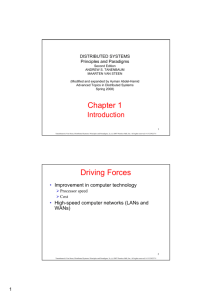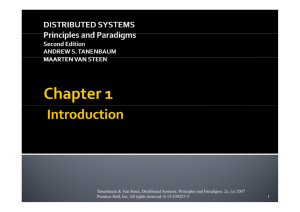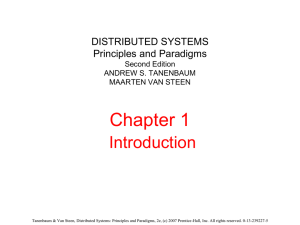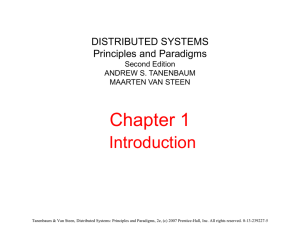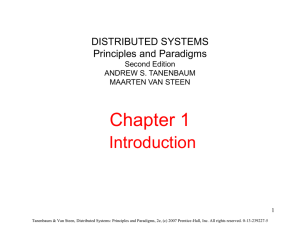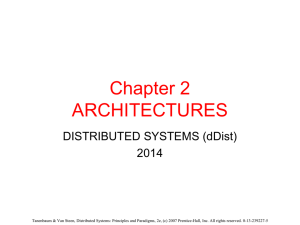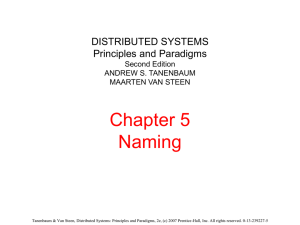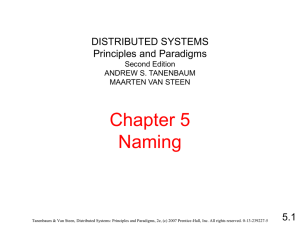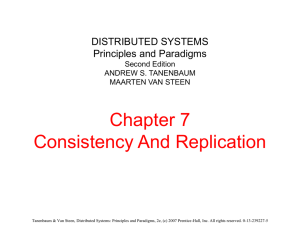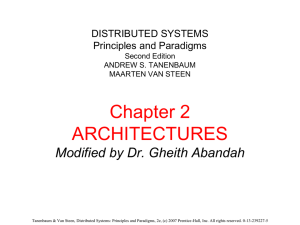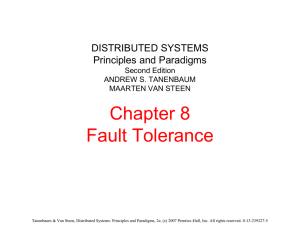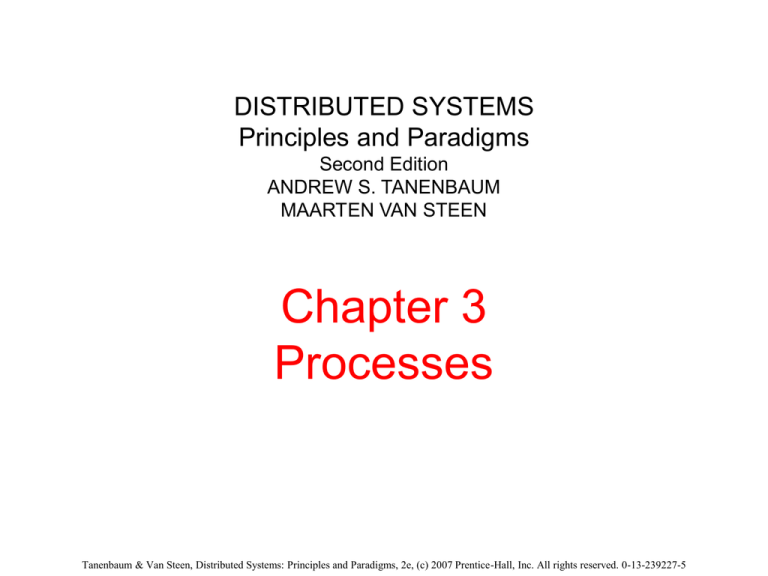
DISTRIBUTED SYSTEMS
Principles and Paradigms
Second Edition
ANDREW S. TANENBAUM
MAARTEN VAN STEEN
Chapter 3
Processes
Tanenbaum & Van Steen, Distributed Systems: Principles and Paradigms, 2e, (c) 2007 Prentice-Hall, Inc. All rights reserved. 0-13-239227-5
Thread Usage in Nondistributed Systems
Figure 3-1. Context switching as the result of IPC.
Tanenbaum & Van Steen, Distributed Systems: Principles and Paradigms, 2e, (c) 2007 Prentice-Hall, Inc. All rights reserved. 0-13-239227-5
Thread Implementation
Figure 3-2. Combining kernel-level lightweight
processes and user-level threads.
Tanenbaum & Van Steen, Distributed Systems: Principles and Paradigms, 2e, (c) 2007 Prentice-Hall, Inc. All rights reserved. 0-13-239227-5
Multithreaded Servers (1)
Figure 3-3. A multithreaded server organized in a
dispatcher/worker model.
Tanenbaum & Van Steen, Distributed Systems: Principles and Paradigms, 2e, (c) 2007 Prentice-Hall, Inc. All rights reserved. 0-13-239227-5
Multithreaded Servers (2)
Figure 3-4. Three ways to construct a server.
Tanenbaum & Van Steen, Distributed Systems: Principles and Paradigms, 2e, (c) 2007 Prentice-Hall, Inc. All rights reserved. 0-13-239227-5
The Role of Virtualization in
Distributed Systems
Figure 3-5. (a) General organization between a program,
interface, and system. (b) General organization of virtualizing
system A on top of system B.
Tanenbaum & Van Steen, Distributed Systems: Principles and Paradigms, 2e, (c) 2007 Prentice-Hall, Inc. All rights reserved. 0-13-239227-5
Architectures of Virtual Machines (1)
Interfaces at different levels
• An interface between the hardware and
software consisting of machine instructions
–
•
that can be invoked by any program.
An interface between the hardware and
software, consisting of machine instructions
–
that can be invoked only by privileged programs,
such as an operating system.
Tanenbaum & Van Steen, Distributed Systems: Principles and Paradigms, 2e, (c) 2007 Prentice-Hall, Inc. All rights reserved. 0-13-239227-5
Architectures of Virtual Machines (2)
Interfaces at different levels
• An interface consisting of system calls as
offered by an operating system.
• An interface consisting of library calls
–
–
generally forming what is known as an application
programming interface (API).
In many cases, the aforementioned system calls
are hidden by an API.
Tanenbaum & Van Steen, Distributed Systems: Principles and Paradigms, 2e, (c) 2007 Prentice-Hall, Inc. All rights reserved. 0-13-239227-5
Architectures of Virtual Machines (3)
Figure 3-6. Various interfaces offered by computer systems.
Tanenbaum & Van Steen, Distributed Systems: Principles and Paradigms, 2e, (c) 2007 Prentice-Hall, Inc. All rights reserved. 0-13-239227-5
Architectures of Virtual Machines (4)
Figure 3-7. (a) A process virtual machine, with multiple
instances of (application, runtime) combinations.
Tanenbaum & Van Steen, Distributed Systems: Principles and Paradigms, 2e, (c) 2007 Prentice-Hall, Inc. All rights reserved. 0-13-239227-5
Architectures of Virtual Machines (5)
Figure 3-7. (b) A virtual machine monitor, with multiple instances
of (applications, operating system) combinations.
Tanenbaum & Van Steen, Distributed Systems: Principles and Paradigms, 2e, (c) 2007 Prentice-Hall, Inc. All rights reserved. 0-13-239227-5
Networked User Interfaces (1)
Figure 3-8. (a) A networked application with its own protocol.
Tanenbaum & Van Steen, Distributed Systems: Principles and Paradigms, 2e, (c) 2007 Prentice-Hall, Inc. All rights reserved. 0-13-239227-5
Networked User Interfaces (2)
Figure 3-8. (b) A general solution to allow access
to remote applications.
Tanenbaum & Van Steen, Distributed Systems: Principles and Paradigms, 2e, (c) 2007 Prentice-Hall, Inc. All rights reserved. 0-13-239227-5
Example: The XWindow System
Figure 3-9. The basic organization of theXWindow System.
Tanenbaum & Van Steen, Distributed Systems: Principles and Paradigms, 2e, (c) 2007 Prentice-Hall, Inc. All rights reserved. 0-13-239227-5
Client-Side Software for Distribution
Transparency
Figure 3-10. Transparent replication of a server
using a client-side solution.
Tanenbaum & Van Steen, Distributed Systems: Principles and Paradigms, 2e, (c) 2007 Prentice-Hall, Inc. All rights reserved. 0-13-239227-5
General Design Issues (1)
Figure 3-11. (a) Client-to-server binding using a daemon.
Tanenbaum & Van Steen, Distributed Systems: Principles and Paradigms, 2e, (c) 2007 Prentice-Hall, Inc. All rights reserved. 0-13-239227-5
General Design Issues (2)
Figure 3-11. (b) Client-to-server binding using a superserver.
Tanenbaum & Van Steen, Distributed Systems: Principles and Paradigms, 2e, (c) 2007 Prentice-Hall, Inc. All rights reserved. 0-13-239227-5
Server Clusters (1)
Figure 3-12. The general organization of a
three-tiered server cluster.
Tanenbaum & Van Steen, Distributed Systems: Principles and Paradigms, 2e, (c) 2007 Prentice-Hall, Inc. All rights reserved. 0-13-239227-5
Server Clusters (2)
Figure 3-13. The principle of TCP handoff.
Tanenbaum & Van Steen, Distributed Systems: Principles and Paradigms, 2e, (c) 2007 Prentice-Hall, Inc. All rights reserved. 0-13-239227-5
Distributed Servers
Figure 3-14. Route optimization in a distributed server.
Tanenbaum & Van Steen, Distributed Systems: Principles and Paradigms, 2e, (c) 2007 Prentice-Hall, Inc. All rights reserved. 0-13-239227-5
Managing Server Clusters
Example: PlanetLab
Figure 3-15. The basic organization of a PlanetLab node.
Tanenbaum & Van Steen, Distributed Systems: Principles and Paradigms, 2e, (c) 2007 Prentice-Hall, Inc. All rights reserved. 0-13-239227-5
PlanetLab (1)
PlanetLab management issues:
• Nodes belong to different organizations.
–
–
•
Monitoring tools available assume a very
specific combination of hardware and software.
–
•
Each organization should be allowed to specify who
is allowed to run applications on their nodes,
And restrict resource usage appropriately.
All tailored to be used within a single organization.
Programs from different slices but running on
the same node should not interfere with each
other.
Tanenbaum & Van Steen, Distributed Systems: Principles and Paradigms, 2e, (c) 2007 Prentice-Hall, Inc. All rights reserved. 0-13-239227-5
PlanetLab (2)
Figure 3-16. The management relationships
between various PlanetLab entities.
Tanenbaum & Van Steen, Distributed Systems: Principles and Paradigms, 2e, (c) 2007 Prentice-Hall, Inc. All rights reserved. 0-13-239227-5
PlanetLab (3)
Relationships between PlanetLab entities:
• A node owner puts its node under the regime of a
management authority, possibly restricting usage
where appropriate.
• A management authority provides the necessary
software to add a node to PlanetLab.
• A service provider registers itself with a
management authority, trusting it to provide wellbehaving nodes.
Tanenbaum & Van Steen, Distributed Systems: Principles and Paradigms, 2e, (c) 2007 Prentice-Hall, Inc. All rights reserved. 0-13-239227-5
PlanetLab (4)
Relationships between PlanetLab entities:
• A service provider contacts a slice authority to
create a slice on a collection of nodes.
• The slice authority needs to authenticate the
service provider.
• A node owner provides a slice creation service
for a slice authority to create slices. It essentially
delegates resource management to the slice
authority.
• A management authority delegates the creation
of slices to a slice authority.
Tanenbaum & Van Steen, Distributed Systems: Principles and Paradigms, 2e, (c) 2007 Prentice-Hall, Inc. All rights reserved. 0-13-239227-5
Reasons for Migrating Code
Figure 3-17. The principle of dynamically configuring a client to
communicate to a server. The client first fetches the
necessary software, and then invokes the server.
Tanenbaum & Van Steen, Distributed Systems: Principles and Paradigms, 2e, (c) 2007 Prentice-Hall, Inc. All rights reserved. 0-13-239227-5
Models for Code Migration
Figure 3-18. Alternatives for code migration.
Tanenbaum & Van Steen, Distributed Systems: Principles and Paradigms, 2e, (c) 2007 Prentice-Hall, Inc. All rights reserved. 0-13-239227-5
Migration and Local Resources
Figure 3-19. Actions to be taken with respect to the references to
local resources when migrating code to another machine.
Tanenbaum & Van Steen, Distributed Systems: Principles and Paradigms, 2e, (c) 2007 Prentice-Hall, Inc. All rights reserved. 0-13-239227-5
Migration in Heterogeneous Systems
Three ways to handle migration (which can be combined)
•
•
•
Pushing memory pages to the new machine and
resending the ones that are later modified during the
migration process.
Stopping the current virtual machine; migrate memory,
and start the new virtual machine.
Letting the new virtual machine pull in new pages as
needed, that is, let processes start on the new virtual
machine immediately and copy memory pages on
demand.
Tanenbaum & Van Steen, Distributed Systems: Principles and Paradigms, 2e, (c) 2007 Prentice-Hall, Inc. All rights reserved. 0-13-239227-5

